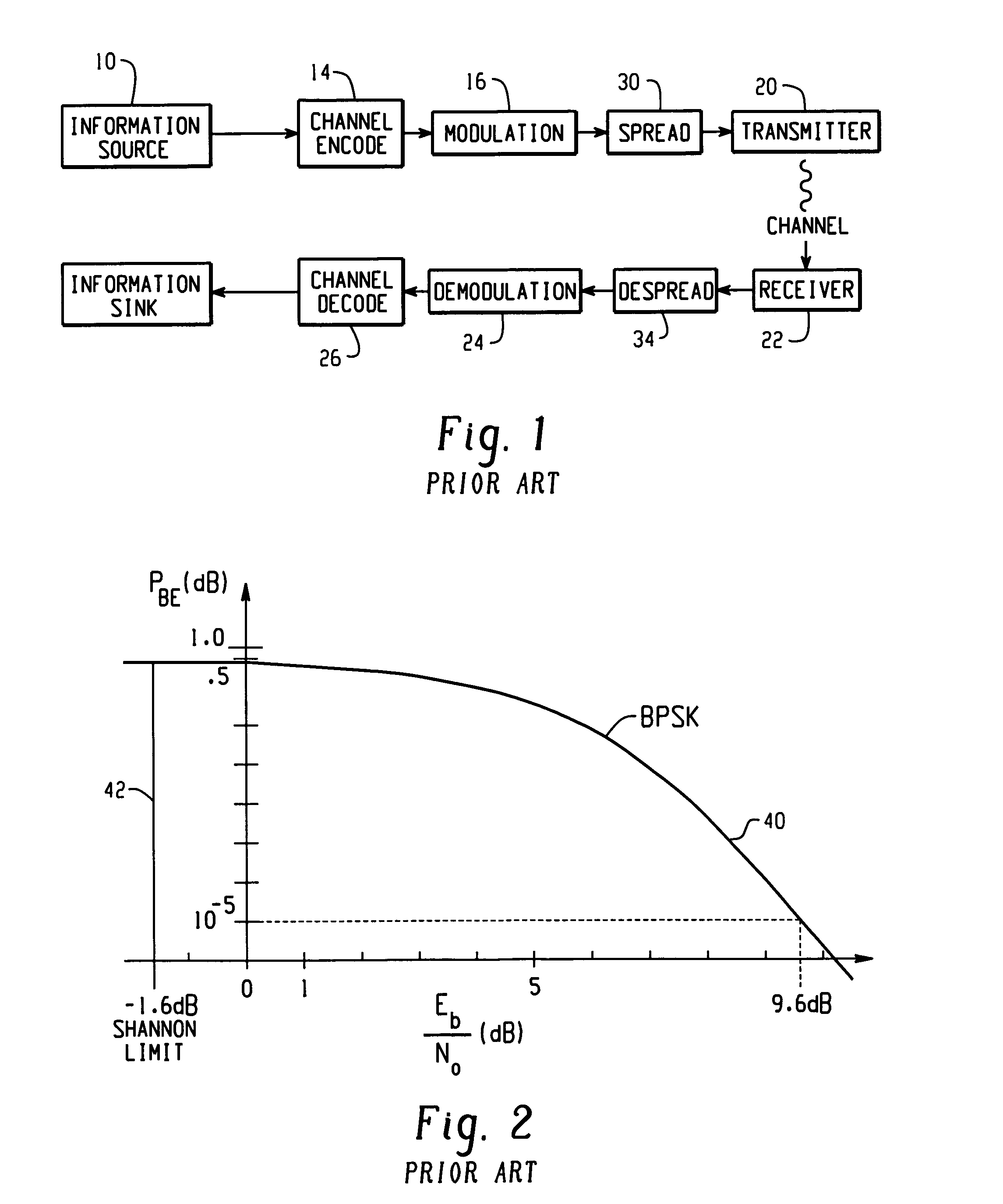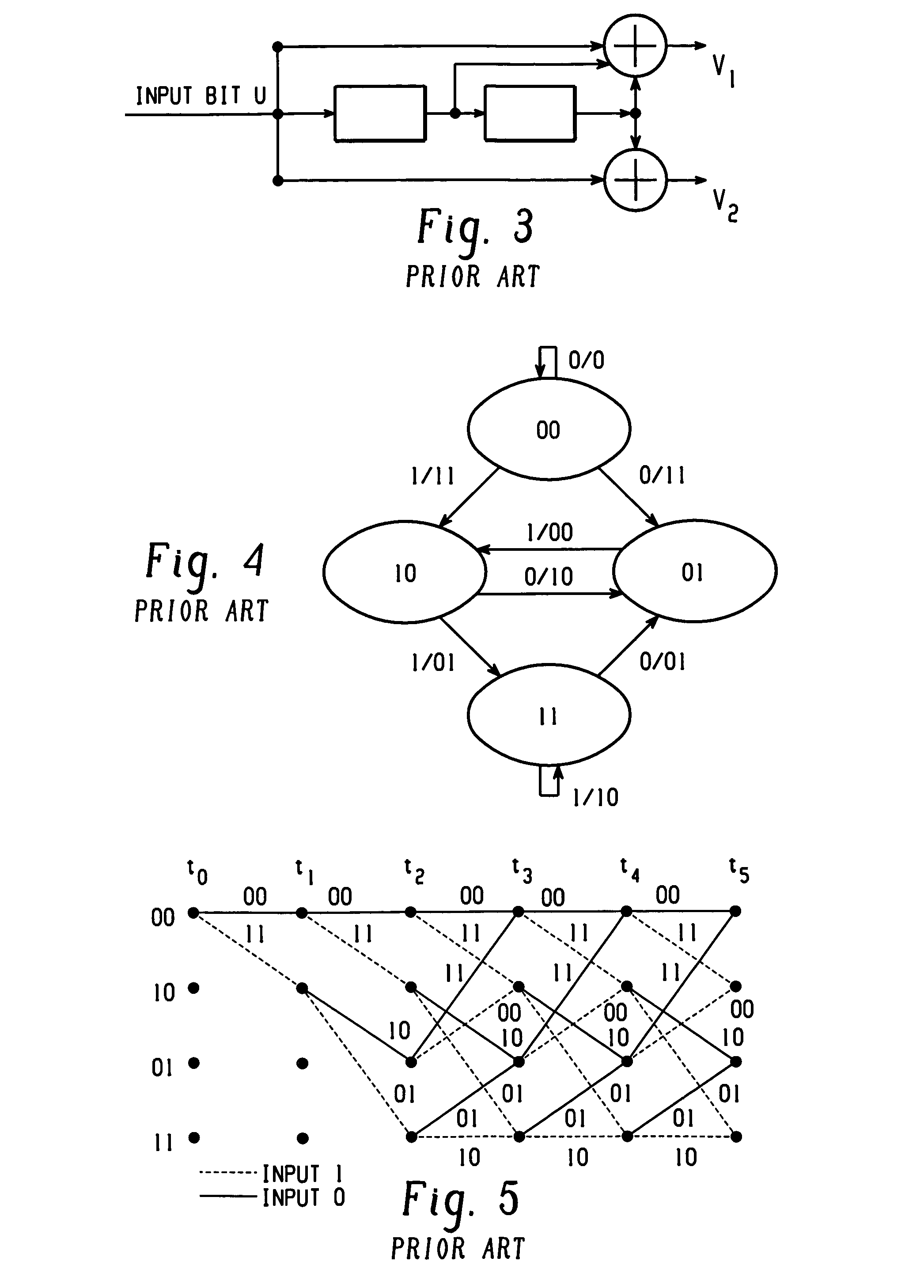Apparatus and method of CTCM encoding and decoding for a digital communication system
a digital communication system and encoder technology, applied in the field of encoders and decoders for digital communication systems, can solve the problems of error coding complexity, price to be paid, translation, etc., and achieve the effect of optimizing energy efficiency
- Summary
- Abstract
- Description
- Claims
- Application Information
AI Technical Summary
Benefits of technology
Problems solved by technology
Method used
Image
Examples
example 1
[0073]Take CTCM (4,3) as an example. The state transition table for this example is shown in Table 1 of FIG. 9. The states are numbered by integer from 1 to 64. It can be found that any member of the set of states{1, 64, 4, 33} can transit to state 1, 2, 5, and 34. Then, the set of states {1, 64, 4, 33} and the set of states {1, 2,5, 34} build a butterfly with such states being the originating states set and the next states set of this butterfly, respectively. This butterfly may be written as butterfly {[1, 64, 4, 33], [1, 2, 5, 34]}. All 16 butterflies may be identified from Table 2 and are illustrated in FIG. 10, where each box represents a butterfly. The originating state set and next state set are in the left side and right side of a butterfly, respectively. By this representation, we regard a butterfly as an ordered structure and refer to a particular arrangement of the states in a butterfly as the internal order of a butterfly. For this example, the location of the state (or t...
example 2
[0075]For CTCM (4,3), Table 2 of FIGS. 12A–12C illustrates all of the 256 paths (rows of the table) for L=D+1=4, wherein the numbers in the columns of a row represent the states along a path with the starting state to the extreme left of each row and the ending state to the extreme right thereof. Transitions originate from states of column i to next states of the adjacent column going from left to right, said transitions representing the state transitions at stage i. The set of 4 state transitions at a stage i on the paths associated with a starting state constitute a simplex-transitioni; for each i, i=1, 2, 3, 4. Note that for this example, there are 64 simplex-transitioni's; for each stage i, i=1, 2, 3, 4.
[0076]For instance, on the 4 paths associated with starting state 3, the set of state transitions at stage 2 (i.e. transitioning states between column 2 and column 3 of Table 2) constitute a simplex-transition2 denoted as simplex-transition2 {4→1, 14→3, 10→6, 50→35}. For a partic...
example 3
[0082]For a CTCM (4,3), compare all the simplex-transitions's from Table 2 of FIGS. 12A–12C with all its 16 butterflies as shown in FIG. 10. For instance, on the 4 paths associated with starting state 3 of the first stage, the simplex-transition1 {3→4, 3→14, 3→10, 3→50}, is contained in butterfly 3, as shown in FIG. 13(a). The simplex-transition4 {2→3, 14→3, 7→3, 36→3} of the last stage is contained in butterfly 2, as shown in FIG. 13(b). The 4 transitions in simplex-transition2 {4→1, 14→3, 10→6, 50→35} of a middle stage are contained in butterflies 1, 2, 4, and 10, respectively as shown in FIG. 13(c). Also, it can be verified that the other 15 transitions in each of the butterflies 1, 2, 4, and 10 constitute the other 15 simplex-transition2's. (end of example)
[0083]In general, for a CTCM (n, D), the following property is observed for a simplex-transitioni, of the middle stages, i.e. 2≦i≦D.
[0084]Property 1
[0085]Consider two simplex-transitioni's: if the originating state (or next st...
PUM
 Login to View More
Login to View More Abstract
Description
Claims
Application Information
 Login to View More
Login to View More - R&D
- Intellectual Property
- Life Sciences
- Materials
- Tech Scout
- Unparalleled Data Quality
- Higher Quality Content
- 60% Fewer Hallucinations
Browse by: Latest US Patents, China's latest patents, Technical Efficacy Thesaurus, Application Domain, Technology Topic, Popular Technical Reports.
© 2025 PatSnap. All rights reserved.Legal|Privacy policy|Modern Slavery Act Transparency Statement|Sitemap|About US| Contact US: help@patsnap.com



